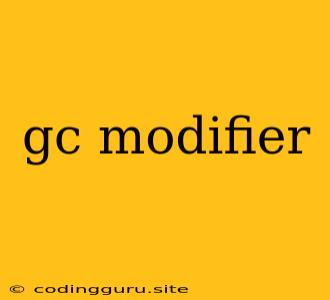Understanding the GC Modifier: A Deep Dive into Garbage Collection Tuning
Garbage collection (GC) is a crucial process in modern programming languages like Java, JavaScript, and others. It automatically manages memory allocation and deallocation, ensuring efficient resource utilization. However, GC performance can significantly impact application responsiveness and overall performance.
Here's where the gc modifier comes in. This powerful tool empowers developers to fine-tune the garbage collector, optimizing its behavior to suit the specific needs of their application. But what exactly is a gc modifier and how does it work?
What is a GC Modifier?
A gc modifier is a command-line argument or a configuration option that allows you to influence the garbage collector's behavior during runtime. It provides a way to control various aspects of the GC process, including:
- GC Algorithm: You can specify which GC algorithm to use, such as generational, concurrent, or parallel.
- Heap Size: You can adjust the size of the heap, influencing how much memory is allocated for objects.
- GC Frequency: You can fine-tune the frequency of garbage collection cycles, affecting how often the GC runs.
- GC Pauses: You can control the duration of GC pauses, minimizing the impact on application responsiveness.
Why Use GC Modifiers?
In many scenarios, the default GC settings may not be optimal for your application. By strategically employing gc modifiers, you can:
- Improve Application Performance: By tuning the GC, you can reduce GC pauses and improve overall throughput, making your application run faster and smoother.
- Reduce Memory Consumption: Optimizing the GC can help manage memory efficiently, minimizing the amount of memory your application uses.
- Tailor GC Behavior: You can fine-tune the GC to suit the specific characteristics of your application, such as its workload, memory usage patterns, and performance goals.
Common GC Modifiers and Their Impact
Let's explore some common gc modifiers and their impact on the GC process:
- -Xms: Sets the initial size of the heap.
- -Xmx: Sets the maximum size of the heap. Increasing the heap size can reduce the frequency of garbage collection but may increase memory consumption.
- -XX:+UseSerialGC: Enables the serial garbage collector, which is simple and suitable for small applications.
- -XX:+UseParallelGC: Enables the parallel garbage collector, which uses multiple threads for faster collection.
- -XX:+UseConcMarkSweepGC: Enables the concurrent mark-sweep collector, which performs most GC work concurrently with the application, reducing pauses.
- -XX:+UseG1GC: Enables the G1 garbage collector, which is designed for large heaps and aims to achieve low pauses.
Examples of GC Modifier Usage
Here are some examples of how to use gc modifiers in different programming languages:
Java:
java -Xms2g -Xmx4g -XX:+UseG1GC MyApplication
This command starts the "MyApplication" with an initial heap size of 2 GB, a maximum heap size of 4 GB, and enables the G1 garbage collector.
JavaScript (Node.js):
node --max-old-space-size=4096 myScript.js
This command runs the "myScript.js" with a maximum old generation heap size of 4096 MB.
Tips for Effective GC Tuning
- Monitor GC Performance: Use profiling tools or logging to monitor the GC's performance and identify areas for improvement.
- Start with Small Changes: Gradually adjust GC settings and observe their impact on your application's performance.
- Test Thoroughly: Before deploying changes to production, thoroughly test them in a controlled environment.
- Consider Your Application's Needs: Tune the GC based on your application's specific workload, memory usage patterns, and performance requirements.
Conclusion
The gc modifier is a powerful tool for optimizing garbage collection performance. By carefully tuning GC settings, you can achieve significant improvements in application responsiveness, resource utilization, and overall performance. Remember to monitor and test your changes thoroughly before implementing them in production.
Remember: The best GC settings for your application will depend on its specific requirements and environment. Experiment with different gc modifiers and find the combination that works best for your needs.
